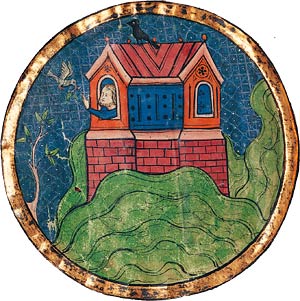
Mountains of Ararat
Encyclopedia

Tiberian Hebrew
Tiberian Hebrew is the extinct canonical pronunciation of the Hebrew Bible or Tanakh and related documents in the Roman Empire. This traditional medieval pronunciation was committed to writing by Masoretic scholars based in the Jewish community of Tiberias , in the form of the Tiberian vocalization...
, Septuagint: ) is the place named in the Book of Genesis where Noah's Ark
Noah's Ark
Noah's Ark is a vessel appearing in the Book of Genesis and the Quran . These narratives describe the construction of the ark by Noah at God's command to save himself, his family, and the world's animals from the worldwide deluge of the Great Flood.In the narrative of the ark, God sees the...
came to rest after the great flood (Genesis 8:4).
In Syrian tradition, as well as in Quranic tradition, the specific summit of the "Mountains of Ararat" where Noah's ark landed is identified as Mount Judi
Mount Judi
Mount Judi , according to very Early Christian and Islamic tradition , is the Noah's apobaterion or "Place of Descent", the location where the Ark came to rest after the Great Flood....
in what is today Nakhchivan or northwestern Iran
Iran
Iran , officially the Islamic Republic of Iran , is a country in Southern and Western Asia. The name "Iran" has been in use natively since the Sassanian era and came into use internationally in 1935, before which the country was known to the Western world as Persia...
. In the Armenian
Roman Armenia
From the end of the 1st century BC onwards, Armenia was, in part or whole, subject to the Roman Empire and its successor, the East Roman or Byzantine Empire...
tradition and Western Christianity, based on Jerome
Jerome
Saint Jerome was a Roman Christian priest, confessor, theologian and historian, and who became a Doctor of the Church. He was the son of Eusebius, of the city of Stridon, which was on the border of Dalmatia and Pannonia...
's reading of Josephus
Josephus
Titus Flavius Josephus , also called Joseph ben Matityahu , was a 1st-century Romano-Jewish historian and hagiographer of priestly and royal ancestry who recorded Jewish history, with special emphasis on the 1st century AD and the First Jewish–Roman War, which resulted in the Destruction of...
, the mountain became associated with Mount Masis (now known as Mount Ararat
Mount Ararat
Mount Ararat is a snow-capped, dormant volcanic cone in Turkey. It has two peaks: Greater Ararat and Lesser Ararat .The Ararat massif is about in diameter...
) the highest peak of the Armenian Highland
Armenian Highland
The Armenian Highland is the central-most and highest of three land-locked plateaus that together form the northern sector of the Middle East...
, located in present day Turkey
Turkey
Turkey , known officially as the Republic of Turkey , is a Eurasian country located in Western Asia and in East Thrace in Southeastern Europe...
. During the Middle Ages, this tradition has eclipsed the earlier association with Mount Judi even in Eastern Christianity, and the Mount Judi tradition is now mostly confined to the Islamic view of Noah.
The "Mountains of Ararat" in Genesis clearly refer to a general region, not a specific mountain. Biblical Ararat corresponds to Assyrian Urartu
Urartu
Urartu , corresponding to Ararat or Kingdom of Van was an Iron Age kingdom centered around Lake Van in the Armenian Highland....
(and Persian Arminya) the name of the kingdom which at the time controlled the Lake Van
Lake Van
Lake Van is the largest lake in Turkey, located in the far east of the country in Van district. It is a saline and soda lake, receiving water from numerous small streams that descend from the surrounding mountains. Lake Van is one of the world's largest endorheic lakes . The original outlet from...
region, which in later centuries, beginning with Herodotus
Herodotus
Herodotus was an ancient Greek historian who was born in Halicarnassus, Caria and lived in the 5th century BC . He has been called the "Father of History", and was the first historian known to collect his materials systematically, test their accuracy to a certain extent and arrange them in a...
, came to be known as Armenia
Roman Armenia
From the end of the 1st century BC onwards, Armenia was, in part or whole, subject to the Roman Empire and its successor, the East Roman or Byzantine Empire...
.
The Book of Jubilees (7:1) specifies that the Ark came to rest on one of the peaks of the "Mountains of Ararat" called "Lubar".
The Latin Vulgate says "requievitque arca [...] super montes Armeniae", which means literally "and the ark rested [...] on the mountains of Armenia", which was changed to "... mountains of Ararat" (montes Ararat) in the modern Nova Vulgata.
In the book, Antiquities of the Jews
Antiquities of the Jews
Antiquities of the Jews is a twenty volume historiographical work composed by the Jewish historian Flavius Josephus in the thirteenth year of the reign of Roman emperor Flavius Domitian which was around 93 or 94 AD. Antiquities of the Jews contains an account of history of the Jewish people,...
, Josephus
Josephus
Titus Flavius Josephus , also called Joseph ben Matityahu , was a 1st-century Romano-Jewish historian and hagiographer of priestly and royal ancestry who recorded Jewish history, with special emphasis on the 1st century AD and the First Jewish–Roman War, which resulted in the Destruction of...
wrote:
Sir Walter Raleigh devoted several lengthy chapters of his History of the World (written c. 1616) to his argument that the "Mountains of Ararat" were anciently understood as including not only those of Armenia, but all the taller mountain ranges extending into Asia far to the east, and that Noah's Ark must have landed somewhere in the Orient, since Armenia is not actually east of Shinar.

